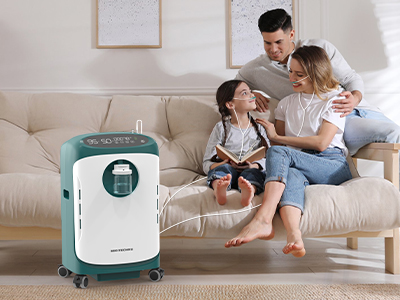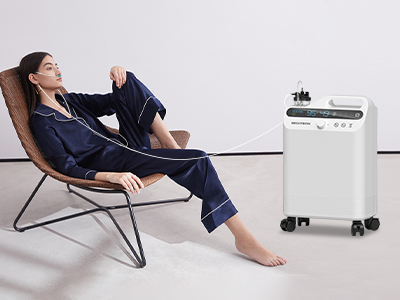18 Nov 2024
Oxygen therapy is an indispensable component of modern medicine. It is a lifeline for individuals battling respiratory illnesses, ensuring their cells receive the oxygen necessary to sustain life. However, this life-saving intervention was not always as accessible or effective as it is today. The history of oxygen therapy and the devices that deliver it—specifically oxygen concentrators—chronicles a remarkable journey of scientific discovery and technological innovation.

The Beginnings of Oxygen Therapy
The origins of oxygen therapy can be traced back to the late 18th century. It was during this era that Joseph Priestley and Carl Wilhelm Scheele independently discovered oxygen as an element. Antoine Lavoisier later identified its role in combustion and respiration. By the early 19th century, scientists began to explore the therapeutic potential of oxygen. Early attempts to use oxygen in medicine involved crude delivery methods, such as simple inhalation from bags or tubes connected to rudimentary pumps.
These early systems were largely experimental and limited in their efficacy. However, they laid the groundwork for future advancements, sparking interest in the development of more reliable methods to administer oxygen to patients.
The Advent of Pressurized Oxygen Cylinders
The 20th century marked a turning point in the practical application of oxygen therapy. Pressurized oxygen cylinders became the standard delivery method, allowing medical professionals to store and administer oxygen with greater precision. During World War I and World War II, these cylinders played a vital role in treating soldiers suffering from respiratory conditions, such as gas poisoning and pneumonia.
Despite their utility, oxygen cylinders had significant limitations. They were bulky, heavy, and required frequent refilling, which restricted their use to hospitals or other controlled environments. The need for a more convenient, portable solution became increasingly evident as the demand for long-term oxygen therapy grew.

The Rise of Oxygen Concentrators
By the mid-20th century, advancements in engineering and medical technology paved the way for a revolutionary shift in oxygen delivery systems: the oxygen concentrator. Unlike pressurized cylinders, concentrators function by extracting oxygen directly from ambient air. This innovation eliminated the need for heavy tanks and provided a continuous, cost-effective supply of oxygen.
The first commercial oxygen concentrators emerged in the 1970s. These early models were designed for stationary use, often for patients confined to their homes. While the initial units were large and somewhat noisy, they represented a groundbreaking step forward, offering patients newfound freedom and reducing their reliance on cylinder deliveries.
Pioneering Oxygen Concentrator Models
The 1970s and 1980s saw the introduction of the first generation of oxygen concentrators. Manufacturers such as Union Carbide Corporation and Bendix Aviation Corporation were among the early pioneers in this field. These devices utilized pressure swing adsorption (PSA) technology, which separates oxygen from nitrogen in the air, producing concentrated oxygen for therapeutic use.
While these early models were revolutionary, they were far from perfect. They were large, energy-intensive, and often stationary. Nevertheless, they demonstrated the potential of oxygen concentrators to transform respiratory care, sparking further innovation in the years to come.
Advancements in Oxygen Concentrator Technology
The 1980s and 1990s were a period of rapid technological evolution for oxygen concentrators. Engineers focused on making these devices smaller, quieter, and more energy-efficient. Portable oxygen concentrators began to emerge, allowing patients to maintain an active lifestyle while receiving therapy.
These advancements included improvements in PSA technology, the development of lightweight components, and the integration of rechargeable batteries. By the turn of the 21st century, portable oxygen concentrators had become a viable alternative to stationary units, providing patients with greater independence and flexibility.
Impact of Oxygen Concentrators on Home Healthcare
One of the most significant contributions of oxygen concentrators has been their impact on home healthcare. Patients with chronic conditions such as chronic obstructive pulmonary disease (COPD) and pulmonary fibrosis now had access to continuous oxygen therapy in the comfort of their homes. This shift reduced hospital readmissions and improved overall quality of life for countless individuals.
The portability of modern oxygen concentrators further enhanced their utility. Patients could travel, exercise, and engage in social activities without the constraints imposed by traditional oxygen tanks. This newfound freedom marked a profound improvement in the way respiratory conditions were managed.
Oxygen Concentrators in Modern Medicine
Today, oxygen concentrators are at the forefront of respiratory care. Modern units are equipped with advanced features, such as digital displays, automatic flow adjustment, and even connectivity to mobile apps for real-time monitoring. The global COVID-19 pandemic underscored the critical importance of oxygen concentrators, as they became a vital resource in managing respiratory distress caused by the virus.
Governments, healthcare organizations, and manufacturers worked together to meet the unprecedented demand for these devices, highlighting their indispensable role in emergency and long-term care settings.
Future Trends in Oxygen Concentrators
The future of oxygen concentrators is one of continued innovation. Researchers are exploring ways to make these devices even more compact, lightweight, and energy-efficient. Advances in materials science and battery technology promise longer-lasting portable units. Additionally, the integration of artificial intelligence and IoT (Internet of Things) is opening new possibilities for personalized oxygen therapy. Patients may soon benefit from devices that adjust oxygen delivery based on real-time physiological data, enhancing treatment outcomes.
Conclusion: A Legacy of Innovation in Oxygen Therapy
The history of oxygen concentrators is a testament to human ingenuity and the relentless pursuit of better healthcare solutions. From the early days of pressurized oxygen cylinders to the sophisticated concentrators of today, these devices have transformed the landscape of respiratory care. As technology continues to evolve, oxygen concentrators will remain a cornerstone of medical innovation, providing hope and improved quality of life to millions around the world.
Keywords: oxygen concentrator
Originally published 18 Nov 2024, updated 18 Nov 2024.